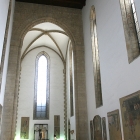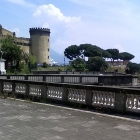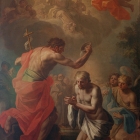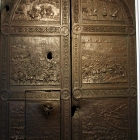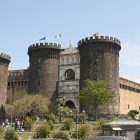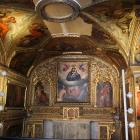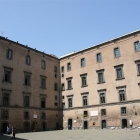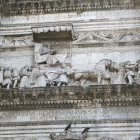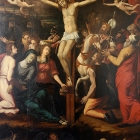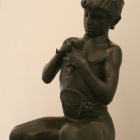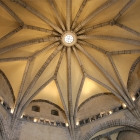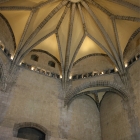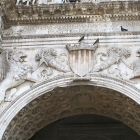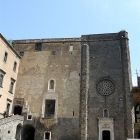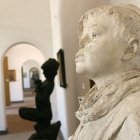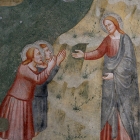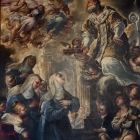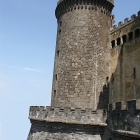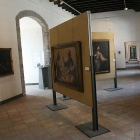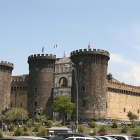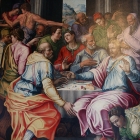Castel Nuovo, the emblem of Naples, once besieged by pirates, now a peaceful museum
A fortress was built in this spot starting 1279, at the orders of Charles I of Anjou by French architect Pierre de Chaule. Even closer to the see, in the Gulf of Naples, there already existed Castel dell Ovo, a smaller fortification with a panoramic view over the shore, and a more retreat Castel Capuano. Thus, the name of Castel Nuovo (The New Castle) for the third castle built by the Anjou dinasty.
The five towers castle we see today is mainly the work of architect Guillem Sagrera, commissioned by Alfonso d’Aragon in the 15 century. In the Renaissance, as Naples was trying to keep up with Florence, a triumphal arch was integrated into the austere castle, at the entrance, after the bridge that crosses the moat.
Though the tradition of the Roman arches built by Latin emperors was to be independent monuments, Aflons of Aragon integrated the white marble arch in the black walls of his fortification, between two towers in fear of it being destroyed during a siege. The arch that celebrates the conquest of Naples by Alfonso of Aragon, is mainly the work of Guillem Sagrera and Pietro da Milano. Its sculptures, presenting the king entering the city and rich decorations create a bridge between the mature Romanesque style and the humanist Renaissance that was rediscovering the Antiquity through archeology at the time, reevaluating it.
When the Bourbons took power in Naples, Castel Nuovo was briefly used by Charles III of Spain, who soon built several palaces that were closer to his lavishing Baroque taste, such as the neighboring The Royal Palace in Naples or the massive Palazzo Real in Caserta.
The fortified castle was the scene of some dramatic events. Constantly under siege by pirates and army canons, was conquered a couple of times by the Hungarian kings, who used Naples as the seat of their emergent little empire. As the royal family was in a close relation with the papacy, it was in Castel Nuovo that a pope resigned, dedicating himself to a secluded life. A plot by local nobility also ended here when the barons were invited for a pretended wedding, only to be locked in a room, and some of the killed. The room is now known as the Hall of the Barons.
But some peaceful things also took place here, as the castle was a welcoming home for the artists of the Humanist era and of the Renaissance. Petrarch and Giovanni Boccaccio were among the famous guests, while Giotto painted some frescoes here.
The Palatine Chapel inside is one of the few remains of the original fortress during the time of Charles I of Anjou. In the somber rooms with stone walls paintings can be admired now. The oldest painting of this museum dates from the 15 century, representing the Madonna with Child, surrounded by saints. Among the most important paintings are “The Crucifixion”, by Battistello Caracciolo, together with other works by Finoglio Paul, Pacecco De Rosa, Bernardo Cavallino, Luca Giordano, Mattia Preti, Paolo De Matteis, together with sculptures by Vicenzo Gemito.
Beside the picturesque towers with corbels and the defense moat on the outside, the Hall of the Barons is the most spectacular architectural element of this building. The high room, now used as city council, has an amazing ceiling with ribbed vaults and decorated wheel windows as sources of light, typical elements for Gothic style.
Inside the museum, only the decorated bronze gate with a canon ball stuck in it remembers the turbulent history of this castle.
- Home Page
start page - Architecture
landmark buildings - Sacred architecture
places of worship - Nature
landscape photography - Concert
performing artists - Christmas
Santa Claus pictures
- Jooble
jobs for photographers - Escape
an out of control blog - Merry Christmas
The best organizer of Christmas parties - Astro photo
Eclipse hunting and astrological photography

